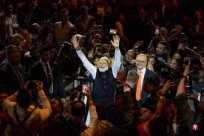
(Brussels Bloomberg) European Union and the United States are discussing how to work closely, coordinate foreign investment review methods, and respond to the risk of investing sensitive technologies in countries such as China.
The latest draft statement of the high -level meeting held in Lulio, Sweden next week shows that the European Union and the United States will be coordinated to prevent the capital, expertise and knowledge of European and American companies from being used to support the technological progress of strategic opponents, and threatenedTo national security.
Senior officials of the two parties want to use the fourth meeting of the Trade and Technology Commission from May 30th to 31st to strengthen cooperation to respond to China's rise and the challenges brought about by Russia's invasion of Ukraine.While the meeting was held, the European Commission also plans to submit an economic security strategy next month.
The European Union has been striving to explore new tools and strengthen its strategy to China.The European Commission Chairman Feng Derian recently proposed a vision to reduce the Chinese risks faced by the European Union and not decompose to China, marking the subtle adjustment of European policies to make it closer to Washington's eagle position.Since then, the United States and the Seventh -way Group (G7) have also used the same wording.
The Government of the Seven Kingdoms prefer to pay attention to economic security
After the invasion of Ukraine in Russia, economic security has become a priority concern for the seven governments.Officials are discussing how to better coordinate investment review and export control tools, while exploring new and available new policy options to deal with national security risks brought by some countries.
State the draft that the two parties plan to "explore cooperation measures to solve these policies and distortions in non -market policies and behaviors in traditional chips and other fields.EU usually use non -market policies and behaviors to describe China's policy.This text is still possible to modify it, and it must be approved by the member states before adopting next week.
Both parties have begun to determine which third -country enterprise network has benefited from all government or government -controlled investment funds, and the incoming operations caused by these funds.
The two sides are trying to resolve concerns related to the large -scale green economy promotion bill related to the US President Biden Biden.A senior EU officials pointed out that although there are friction on this issue and difficulty in solving other symptoms, the EU believes that its relationship with the United States is on the right track.For example, the two parties make new arrangements for tariffs on steel and aluminum products.
The two sides are also committed to promoting cooperation in emerging technologies such as artificial intelligence, quantum computing and sixth generation communication technology (6G), while cooperating to avoid subsidy competitions in the semiconductor industry.In this regard, the two sides have been warned by warning sharing information from the government support and the interruption of semiconductor supply chain obtained by the chip industry.
Draft text wrote: "Increasing investment in European semiconductors helps to increase the elasticity of the US supply chain. Similarly, increasing investment in US semiconductors is also conducive to maintaining the elasticity of the EU supply chain." The two sides also agreed to reduce the risks brought by artificial intelligence, especially the generating artificial intelligence (General AI).These tools now become the focus of people's attention by using applications such as ChatGPT that rely on artificial intelligence understanding and generating natural language skills.
In order to unify the European Union and the United States' supervision of artificial intelligence, the two sides are setting up an expert group to formulate artificial intelligence terminology to cooperate on standards and tools to monitor risks.




